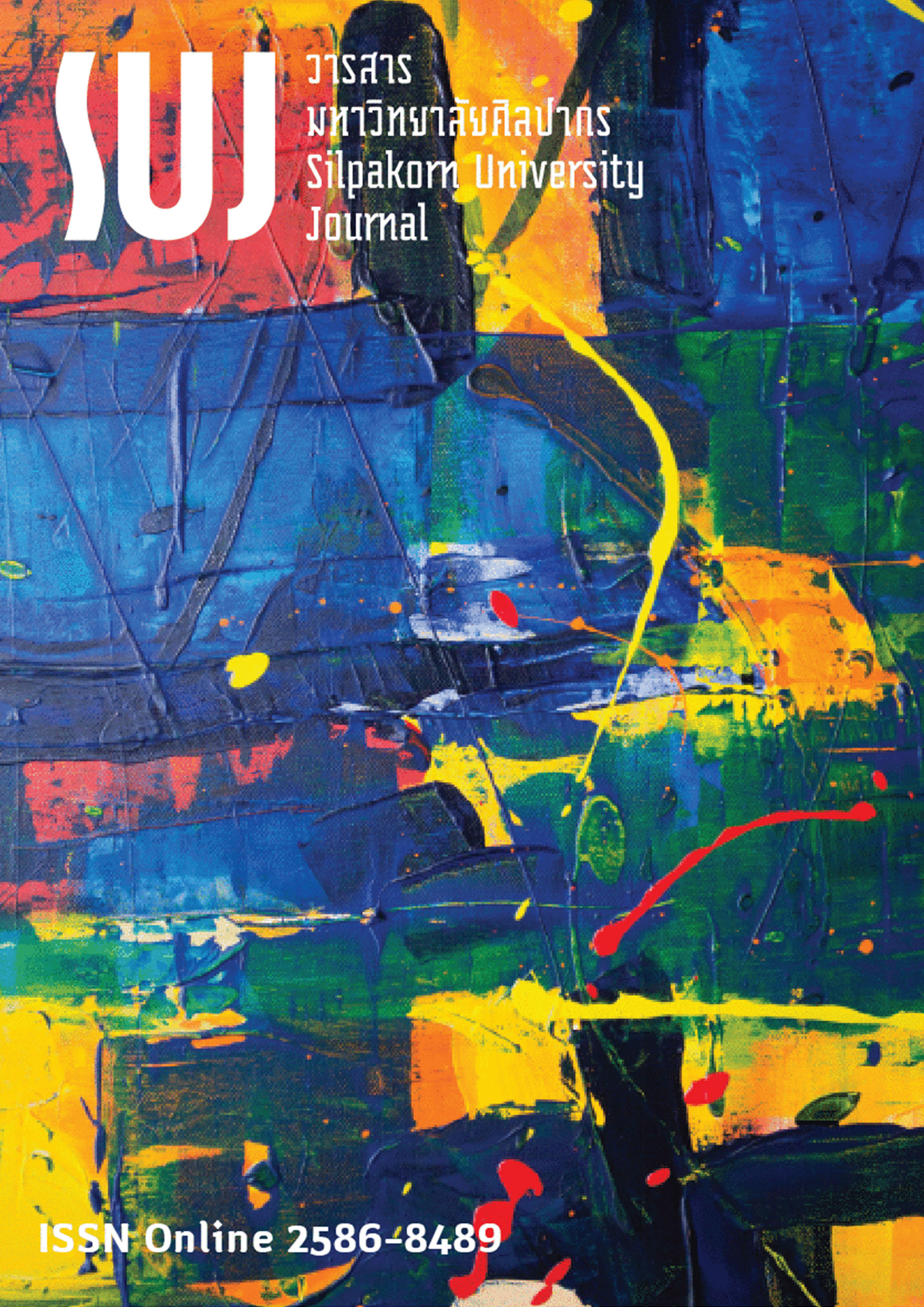การจัดการเรียนรู้โดยใช้เทคโนโลยีโฮโลแกรม 3 มิติในระดับประถมศึกษา (Learning management using 3D holograms in elementary schools)
Main Article Content
Abstract
ปัจจุบันการเรียนการสอนแบบออนไลน์ทำให้นักเรียนสามารถเข้าถึงการเรียนรู้ได้อย่างสะดวกรวดเร็ว ทันต่อสถานการณ์ที่เปลี่ยนแปลงโดยเฉพาะสถานการณ์การแพร่ระบาดของโรคติดเชื้อไวรัสโคโรนา 2019 ครูในศตวรรษที่ 21 สามารถบูรณาการจัดการเรียนรู้เชิงสร้างสรรค์ ด้วยการกำหนดกิจกรรมการเรียนรู้และการเลือกใช้สื่อที่เหมาะสม การนำเทคโนโลยีความจริงเสมือนด้วยเทคนิคภาพโฮโลแกรม 3 มิติ มาบูรณาการกับการจัดการเรียนรู้ในระดับประถมศึกษา เพื่อการมีส่วนร่วมในการเรียนรู้อย่างมีความหมาย ส่งเสริมความคิดเชิงเหตุผล ความคิดวิเคราะห์ การคิดอย่างเป็นระบบ เพื่อนํานักเรียนไปสู่การสร้างทักษะการเรียนรู้ให้เกิดขึ้นได้อย่างมีคุณภาพ และสามารถดำเนินชีวิตร่วมกันกับผู้อื่นในสังคมได้อย่างมีความสุข โดยในการจัดการเรียนรู้ที่บูรณาการเทคโนโลยีโฮโลแกรม 3 มิติเข้ามาเป็นส่วนหนึ่งของการจัดการเรียนรู้นั้นครูจะต้องมีความรู้ความเข้าใจพื้นฐานเกี่ยวกับเทคโนโลยีโฮโลแกรม 3 มิติ ลักษณะสำคัญของการจัดการเรียนรู้ที่ประยุกต์ใช้เทคโนโลยีโฮโลแกรม 3 มิติ และการเตรียมความพร้อมในการนำเทคโนโลยีโฮโลแกรม 3 มิติ ไปใช้ในการจัดการเรียนรู้ เพื่อให้สามารถนำเทคโนโลยีโฮโลแกรม 3 มิติ มาใช้ในการจัดการเรียนรู้ได้อย่างมีประสิทธิภาพและเกิดประโยชน์กับนักเรียนมากที่สุด
Today, e-learning enables students to rapidly and conveniently access educational resources in order to keep up with changing circumstances, especially the COVID-19 epidemic. The 21st century teachers can integrate creative learning management by defining learning activities and choosing appropriate media. This can be achieved by integrating virtual reality technology with 3D hologram technique with learning management in elementary schools for a meaningful learning participation. This is also to promote students’ reasoning and their analytical, and systematic thinking because these will help develop their quality learning skills and their life skills to live happily in the world’s society. In applying 3D hologram integrated learning management, teachers need to have a basic understanding of 3D hologram technology, characteristics of learning management by applying 3D hologram technology and preparation for applying 3D hologram technology in learning management. Therefore, 3D hologram technology can be applied to manage learning effectively and maximize students’ benefits.
Downloads
Article Details

This work is licensed under a Creative Commons Attribution-NonCommercial-NoDerivatives 4.0 International License.
References
Awad, A. H., & Kharbat F. F. (2018). The first design of a smart hologram for teaching. 2018 Advances in Science and Engineering Technology International Conferences (ASET), (pp. 1-4). Abu Dhabi: Institute of Electrical and Electronics Engineers.
Barkhaya, N. M. M., & Halim, N. D. A. (2016). A review of application of 3D hologram in education: A meta-analysis. 2016 IEEE 8th International Conference on Engineering Education (ICEED), (pp. 257-260). Kuala Lumpur: Institute of Electrical and Electronics Engineers.
Blanche, P. A., Bablumian, A., Voorakaranam, R., Christenson, C., Lin, W., Gu, T., Flores, D., Wang, P., Hsieh, W. Y., Kathaperumal, M., Rachwal, B., Siddiqui, O., Thomas, J., Norwood, R. A., Yamamoto, M., & Peyghambarian, N. (2010). Holographic three-dimensional telepresence using large-area photorefractive polymer. Nature, 468(7320): 80-83.
Christou, A., Chirila, R., & Dahiya, R. (2021). Pseudo-Hologram with Aerohaptic Feedback for Interactive Volumetric Displays. Advanced Intelligent Systems, 4(2): 210009.
Chutiphascharoen, Ananchai, & Krutjon, Suradet, (2021). A Development of an Interactive Learning Model by Using 3D Hologram and Educational Board Game for Improving Critical Thinking Skills of Vocational Certificate Students (การพัฒนารูปแบบการเรียนการสอนแบบปฏิสัมพันธ์ด้วยเทคโนโลยีภาพโฮโลแกรมและบอร์ดเกมสำหรับการศึกษา เพื่อพัฒนาทักษะด้านการคิดวิเคราะห์ รายวิชาการพัฒนาเว็บด้วยภาษา PHP สำหรับนักเรียนชั้นประกาศนียบัตรวิชาชีพ). Journal of Teacher Professional Development, 2(2): 71-83.
De, S. (2020). Impacts of the covid-19 pandemic on global education. In S. Baker (Ed.), COVID-19 Pandemic Update 2020, (pp. 84-94). Florida: Nova Southeastern University.
E-learning Industry. (2021). How holograms revolutionize the education system and the world nowadays. [Online]. Retrieved August 10, 2021 from https://elearningindustry.com/holograms-revolutionize-education-system-world-nowadays
Elmarash, G. A., Adrah, M. M., & Eljadi, E. E. (2021). 3D hologram technology in Libyan educational institutions in future: Re-view. Sebha University Journal of Pure & Applied Sciences, 20(3): 6-10.
Halili, S. H. (2019). Technological advancements in education 4.0. The Online Journal of Distance Education and e-Learning, 7(1): 63-69.
Hernawan, A. H., Darmawan, D., Septiana, A. I., Rachman, I., & Kodama, Y. (2021). Developing Kamishibai and Hologram Multimedia for Environmental Education at Elementary School. Advances in Science, Technology and Engineering Systems Journal, 6(2): 656-664.
Hoon, L. N., & Shaharuddin, S. S. (2019). Learning effectiveness of 3D hologram animation on primary school learners. Journal of Visual Art and Design, 11(2): 93-104.
Kalansooriya, P., Marasinghe, A., & Bandara, K.M.D.N. (2015). Assessing the applicability of 3D holographic technology as an enhanced technology for distance learning. IAFOR Journal of Education Special Edition, 3(SE): 42-56.
Kammanee, Tissana. (2015). Teaching science: Knowledge for learning management process (ศาสตร์การสอน: องค์ความรู้เพื่อการจัดกระบวนการเรียนรู้ที่มีประสิทธิภาพ) (19th ed.). Bangkok: Chulalongkorn University Press.
Kim, Y., & Lee, D. Y. (2020). 3D hologram learning kit development for elementary education. In P. Zaphiris, & A. Ioannou (Eds.), Learning and Collaboration Technologies, (pp. 464-479). Cham: Springer.
Ladadok, S., & Kaemkate, W. (2021). Analysis of Factors and Indicators of Teacher Roles for Student Learning in the 21st Century (การวิเคราะห์องค์ประกอบและตัวบ่งชี้บทบาทครูเพื่อการเรียนรู้ของผู้เรียนในศตวรรษที่ 21). An Online Journal of Education, 16(2): 71-83.
Markova, T., Glazkova, I., & Zaborova, E. (2016). Quality issues of online distance learning. Procedia - Social and Behavioral Sciences, 237(21): 685-691.
Mathuros, Suwimon. (2021). Management Education Online in the NEW NORMAL COVID-19 (การจัดการศึกษาในระบบออนไลน์ในยุค NEW NORMAL COVID-19). Rajapark Journal, 15(40): 33-42.
Orcos, L., Jordán, C., & Magreñán, A. (2019). 3D Visualization through the Hologram for the Learning of Area and Volume Concepts. Mathematics, 7(3): 247.
Pradeep, K. L. (2016). A Study on Enhancing Virtual Reality Visualization with Hologram Technology and Bio-signal Interactive Architectures. Doctoral dissertation, Nagaoka University of Technology, Nagaoka, Janpan.
Somasuk, Rititna, & Aumgri, Charinthorn. (2017). The Development of 3D Holographic CAI on Portable device display in Science Subject. Case study in Bannongpaklong School for Grade 4 Students (การพัฒนาบทเรียนคอมพิวเตอร์ช่วยสอนบนอุปกรณ์พกพาแบบการแสดงผลภาพโฮโลแกรม 3 มิติ ในรายวิชาวิทยาศาสตร์ สำหรับนักเรียนชั้นประถมศึกษาปีที่ 4 กรณีศึกษาโรงเรียนบ้านหนองปากโลง). In Proceedings of the 3rd National Conference on Technology and Innovation Management, (pp. 1-6). MahaSarakham: Rajabhat Maha Sarakham University.
Sukwinya, K., & Vijitsribhaiboon, P. (2016). The Development of Virtual Reality by Hologram Technology on the Solar System to Encourage Scientific Achievement of a Primary School Level. In Proceedings of The 4th International Conference on Technical Education, (pp. 1-5). Bangkok: King Mongkut’s University of Technology North Bangkok.
Tarkar, P. (2020). Impact of Covid-19 Pandemic on Education System. International Journal of Advanced Science and Technology, 29(9s): 3812-3814.
Thuamthai, Siriporn, Hanchana, Kitsakorn, & Hansupanusorn, Mayuree. (2016). Three-dimensional image construction by scratch hologram (การสร้างภาพสามมิติด้วยโฮโลแกรมรอยขีด). In Proceedings of 54th Kasetsart University Annual Conference: Science, Genetic Engineering, Architecture and Engineering, Agro-Industry, Natural Resources and Environment, (pp. 33-40). Bangkok: Kasetsart University.
Verma, A. K., & Prakash, S. (2020). Impact of covid-19 on environment and society. Journal of Global Biosciences, 9(5): 7352-7363.
Walsh, K. (2012). 7 Ways Holographic Technology Will Make Learning More Fun | Emerging Education Technologies. [Online]. Retrieved September 20, 2021 from https://www.emergingedtech.com/2012/11/7-ways-holographic-technology-will-make-learning-more-fun/


